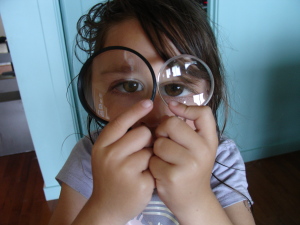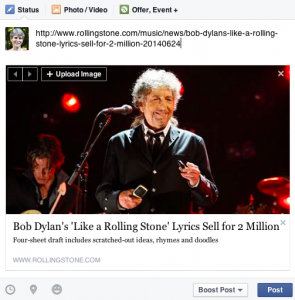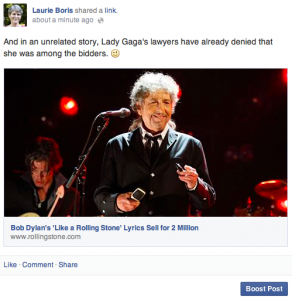 Those of you who have Facebook pages or read Jim Devitt’s posts probably know that the social media giant is showing a ridiculously small percentage of your fan page posts to your readers, and that this percentage has been dropping lately. Right now, going by an average of my last few posts, I’m reaching about 4% of my fans. Which is pretty sucky. Even if you “like” a page, Mark Zuckerberg and friends have drafted an algorithm that combines newsworthiness and reader engagement over time into your “EdgeRank,” a rating that decides what will show up in your feed and what gets jettisoned. Some have said that the concept of “EdgeRank” is dead and it’s not even worth your trouble to hope for too much engagement from your posts unless you buy ads or shell out for “sponsored posts.”
Those of you who have Facebook pages or read Jim Devitt’s posts probably know that the social media giant is showing a ridiculously small percentage of your fan page posts to your readers, and that this percentage has been dropping lately. Right now, going by an average of my last few posts, I’m reaching about 4% of my fans. Which is pretty sucky. Even if you “like” a page, Mark Zuckerberg and friends have drafted an algorithm that combines newsworthiness and reader engagement over time into your “EdgeRank,” a rating that decides what will show up in your feed and what gets jettisoned. Some have said that the concept of “EdgeRank” is dead and it’s not even worth your trouble to hope for too much engagement from your posts unless you buy ads or shell out for “sponsored posts.”
Some social media experts think there’s still a way to work it. We had a great guest post about some of the ways Shawn Inmon has improved his stats. And at least since the end of April, when it was announced in a press release from Facebook, there’s a move afoot to reduce what FB considers “unengaging” posts: frequently shared content (like memes), like-baiting (overtly asking for likes, clicks and shares above and beyond what a post might normally receive), and spammy links. So what does this mean for you?
Depending on what you post, it could mean fewer people getting your updates. With a little attention, you can craft fan page posts to take advantage of some new research and attempt to resurrect a failing page.
First. Look at the content you’re sharing. Is it something that will engage your particular audience? If you can’t always post original content, research suggests that sharing popular, current content from popular sites (like big news sites) will get you seen more frequently.
Second. Craft the post to your greatest advantage. Have you noticed that images across nearly all the social media sites are getting bigger? Blame the iPhone people. Blame popular culture and our declining attention span. I’d love to have a discussion about the chicken-or-egg-ness of this one day, but right now, what gets shared? Research claims it’s big images, links that don’t have a lot of text, and status updates that engage readers without hammering them over the head with too many pushy “calls to action.” Basically, as social media maven Martha Frankel once said, “Facebook is like Jersey Shore.” Like Snooki, we’re overexposed, and we don’t want to work too hard.
How to craft a status update that has a better chance of getting seen:
1. On your Facebook page status window, paste the link you want to share. Since I live near Dylan’s former home in Woodstock—and one of my books is set there—for this example, I’m sharing a post about a recent auction of his early drafts of “Like a Rolling Stone.” (He tried to rhyme “vermouth” with something, and it really didn’t work.)
2. When the link pops up, DON’T hit “post” yet. We’re going to play with it first.
3. If applicable, find a more engaging image than the preview shows. Make sure it’s optimized for Facebook sharing. According to the 2014 layout changes, optimal size for “shared link thumbnails” (that you want to show up nice and big on your fan page) is 484px by 252px. Yeah, it’s kind of confusing. Jim Devitt described some of Facebook Page’s new moves on his blog.) The image that came with this preview link happens to be the perfect size, so we’ll leave it. If you want to choose a different image, click “upload image” in the top left of the photo preview.

4. Delete the preview text at the bottom by clicking on it and then deleting. Recent research suggests that fewer people are reading it. Especially younger people—something to keep in mind if that’s your audience. You can also use this handy feature to correct typos in the preview text or even write your own.
5. Craft a message for your status that is engaging but does not have an overly pushy “call to action.” Emoticons are fun to toss on there, if appropriate. Facebook even suggests adding relevant tags to your status message, to draw in those who might be interested in what you’re sharing. For example, I could have added a tag for Bob Dylan’s page or The Band’s page or something about Woodstock. But the data is still out on that score. Just as long as you keep your audience in mind when you’re drafting a message. Coffee is a popular topic on my page, for some reason. So are grammar jokes. Watch your Insights for a while to see what kind of posts get the most attention on your page.
6. Monitor the results.
If you’ve done all this, but you’re getting a big fat goose egg, some experts suggest deleting the post, because it could work against your rating.
SOS For Your Facebook Page
Have you been neglecting your page? If you’re seeing lousy stats, try this: find some generic, current, popular posts from popular websites. Post two or three a day for a while, and monitor your results.
In general, we around the gruel pot have found that these measures are hit-or-miss at best. My experiment is still ongoing, and some posts have drawn more than others. At some point, I’ll report back on the progress. Oh, I hope there will be progress. But why not give it a shot? I mean, can I get any suckier than 4%?
Has anything worked for you to get your visibility up without paying?




I’m afraid to do the math for my Facebook page. Thanks for the tips, Laurie!
Sure thing, Lynne. I’m still working it. Weirdly, the thing that usually gets me the least attention are book promos, and that’s been outscoring the coffee jokes this week. Scratching my head…
It seems to me that Facebook stats mean less than nothing. Each week I post anything up to fifty things, both on my own and on other people’s pages, and yet they invariably tell me I have reached a minus 5 of people since the week before, have no exchanges (despite some vigorous discussions I have participated in, and they leave me wondering why I bother.
Half the tings I post on my own pages either don’t show up at all or get corrupted. That’s not very clever.
Hopefully they’ll realize how unclever they’ve been lately. I choose to remain optimistic. 😀 For now.
I doubt that. This morning I received notification that I had given no Likes, contacted no other people, posted nothing and extended my presence by 0%. This after five days in which I have posted seventeen things, contributed to eleven discussions, liked nine things and met two new people asking me to be friends.
I kept a paper record just to be sure, but if FB’s analytics can’t even pick that up, what hope is there?
Great tips, Laurie. Thank you. I had no idea about the image size and I’ve been wondering why mine come up so small–didn’t know I could switch images, but I do now :-).
Pete, I figured it out almost by accident. Blogger often doesn’t play nice with Facebook, and will link to one of the pictures in the sidebar of my blog instead of the pic that goes with the blog post. When I realized I could swap out the image instead of using the one they randomly chose, I was a much happier camper.
Thanks for stopping by, Pete. I was psyched to learn about the image sizes, and that I could modify the text in the link preview. Great for those articles with typos in their teasers.
Good tips, Laurie. I find the whole Facebook thing frustrating because it’s hard to figure out what exactly works and what doesn’t. Plus, you’re darned if you do and darned if you don’t. I actually had a Facebook post that was doing pretty well, and Facebook sent me a message saying (and I’m summarizing because I don’t remember the exact message): This post is doing better than 90 percent of your other posts. Would you like to pay to boost it and reach even more people?
They only want to pull money from pages. I understand the need for earning money, but spending to boos posts has to add some long-term value. Pages can’t pay to boost posts, only to have to do it again the next day. And having it be so hit or miss when you try optimizing posts through techniques like you to described makes it hard to get excited about posting. Though, I must admit it is great when a post actually reaches a lot of your fans.
Thanks, RJ. It’s SO frustrating. You never know sometimes what’s going to click. Or what’s going to fail miserably. Maybe that’s part of what keeps me trying. 😉
This social networking thing is really, really frustrating! But thanks for the info, Laurie.
Oh, it can be, TD. But I’m trying to stay curious about these things and see how I can connect with people better. I’m glad you came by.
Interesting. I never believed in pages. People seem to see what I post to my timeline, but I put my real faith in groups. I haven’t seen anything to indicate that all members of a group don’t get notifications on posts there.
Actually, Lin, I turn off my group notifications all the time. I think there is only one group from which I actually receive all the notifications. Most of my groups are set to notify me only if a friend posts. So, there’s no guarantee that any of the members receive notifications. Sorry.
Maybe groups is the way to go, then. It looks very much as if FB don’t like the rubbish so many people pot on their timelines, whereas people in groups seem to think a little before they post. There’s probably more to be made out of that.
Sorry, but I also turn off a lot of my group notifications—usually friend posts only. Or else I’d be DROWNING in email. I check in now and again to see what’s going on, though.
I don’t think you get email from group notifications. In my experience, they show up in a list with you click the little globe at top your your page. A quick scan down an you can look at whatever you want. The idea, to me, is to reach people who are interested in what I’m showing.
Good stuff, LB.
Thanks, JD. Nice to see you. 😀
I remember reading a while back that pictures got way more views than posts with links, so as often as possible I try to post pics. I’ll often put links in a comment below. But it’s all such a moving target, who knows what will work tomorrow? Thanks, Laurie.
I never ask for likes or do anything like that on FB. I just put up whatever photos or news or nuttiness is happening in my life and I often get over 40 likes and lots of comments. I made this crazy photoshopped image of mist fairies in our forest and it got shared in Latvia! I think its a lot of fun and I never think about it too much. Just do it if you enjoy it and if you don’t it won’t work anyway. Sometimes it even helps me sell a book!
My stuff is mostly original but occasionally I put something up I found elsewhere, like a photo of a dolphin shaped cloud I saw recently.
The fairies photo got 49 likes, six shares, including three in Europe and dozens of comments. It’s here:
https://fbcdn-sphotos-c-a.akamaihd.net/hphotos-ak-xpf1/t31.0-8/10455001_10152198678423269_1025750993441399689_o.jpg
I google translated the Latvian one and she was telling people there about my writing.So that was useful, I suppose. The photo was nothing to do with my work. It was just fun.
Here’s a question, if an image gets say 49 likes, does that mean it gets a lot more than that of people who just view it without liking?
One of the people who saw the image and knew I was a writer, begged me to write a story about the mist fairies! Unfortunately, good plot did not spring immediately to mind.
Thanks, Laurie. Where do you find who is seeing your posts? I’ll try some of your tips and see if it makes a difference.
I recently posted a photo of my bougainvilleas to my author page by mistake – I meant it for my personal page. I decided to leave it there and see what would happen. When I went back later, I saw that 101 people saw the post, many more than my promo posts, which usually average teens to thirties. Maybe I should have added a link to my Amazon author page at the bottom. 🙂
Don’t knock it, Helen. Getting noticed for your Bougainvilleas is quite an achievement. I should post a separate notice about it on your other FB page ( with a cross link) and see what happens. If you can slip in a bit about your writing at the same time, maybe people will look at that too.
I like Bougainvilleas too.